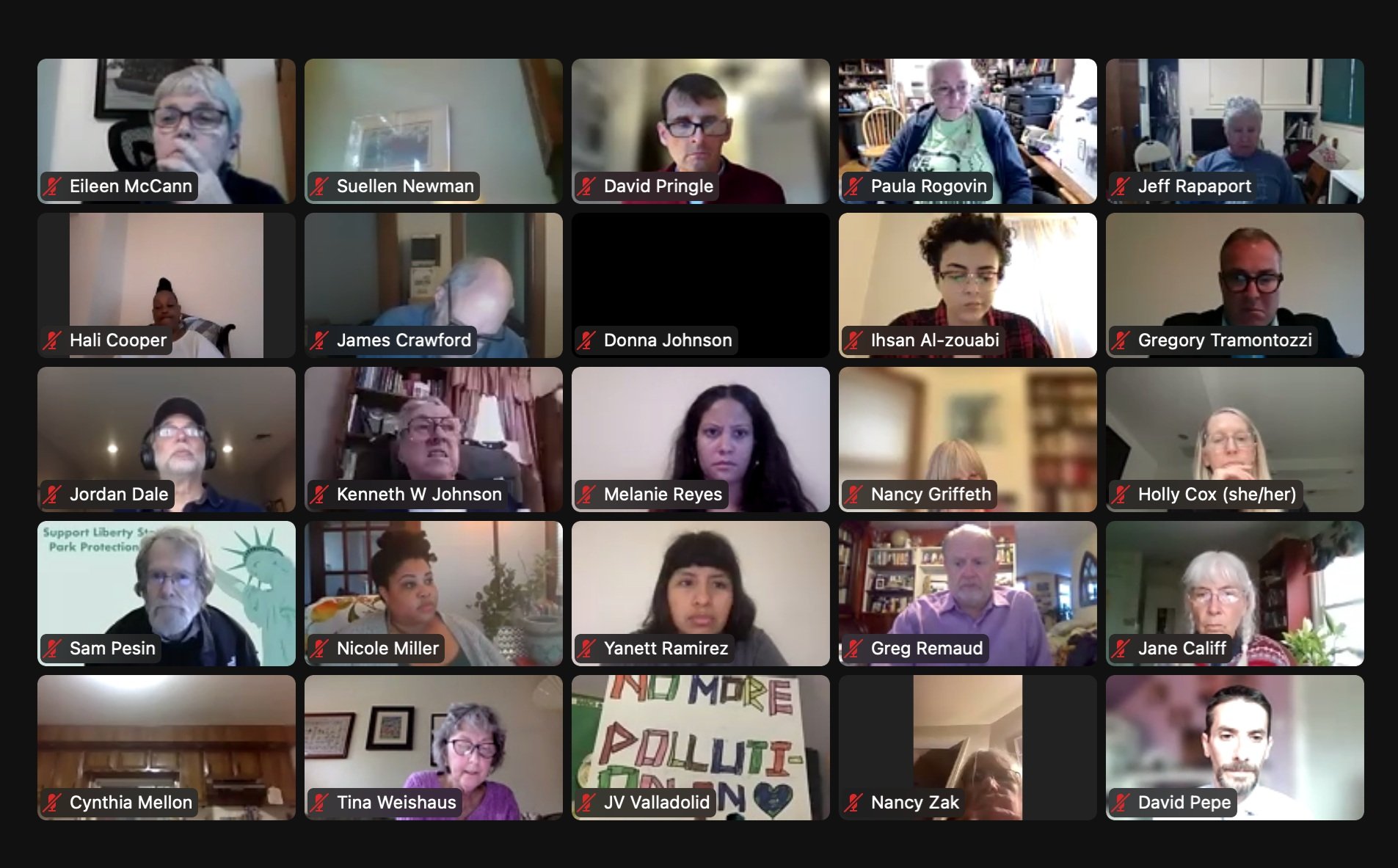As Regulations Under the Environmental Justice Law are Pending, PVSC Continues to Push For a New Power Plant in Newark
On April 26, the Passaic Valley Sewerage Commission (PVSC) held a virtual public hearing to receive oral and written comments on its Title V Air Permit Modification Application, as required under Administrative Order 2021-25.
NEWARK, NJ—At a virtual public hearing in April, several Newark residents and New Jersey activists opposed the Passaic Valley Sewerage Commission’s (PVSC) air permit modification application, which would allow PVSC to operate a standby power generation facility. Although part of a resiliency project initiated after Hurricane Sandy, the gas-powered facility would be the fourth power plant in or near the Ironbound neighborhood of Newark, a community already suffering from high levels of air pollution from numerous pollution sources.
“In the plant's documents, it says it wants to be a good neighbor, and it wants to operate in the spirit of environmental justice. This is how you operate in the spirit of environmental justice: don't build the plant or at least subject it to the new EJ Law [Environmental Justice Law] when it’s fully operational,” said Dr. Nicky Sheats, the president of the New Jersey Environmental Justice Alliance (NJEJA) and director of the Center for the Urban Environment at the John S. Watson Institute for Urban Policy and Research at Kean University.
Even though Administrative Order 2021-25 enforces the EJ Law by establishing a public hearing and compliance process, environmental justice regulations are still pending. These regulations will be released for a public comment period sometime this year, followed by a review and response by the New Jersey Department of Environmental Protection (NJDEP).
Keith Voos, the health, environment and pollution subcommittee chair at the NAACP Metuchen-Edison Branch, reminded the NJDEP and PVSC that environmental justice means there should be no difference in the quality of life enjoyed by people of different means in a just society.
"All people would experience life in healthy, thriving environments," he explained. “That situation emphatically does not pertain to Newark compared to several other communities in close proximity.”
Gov. Phil Murphy signed the EJ law in 2020 in the Ironbound community to protect low-income communities and communities of color that are disproportionately subjected to higher environmental and public health impacts, including pollution from industrial, commercial and governmental facilities.
The EJ Law requires the NJDEP to evaluate the environmental and public health impacts of renewed air permits and certain facilities, such as new power plants and incinerators, on overburdened communities—minority, low-income or tribal communities.
Under the EJ Law, overburdened communities are defined as any census block group or census area where at least 35 percent of households are low-income, 40 percent identify as minority or as members of a state-recognized tribal community, or at least 40 percent of households have limited English proficiency—without an adult that speaks English or speaks it very well.
The NJDEP recognizes Newark as an overburdened community, and Newark has a cumulative impact problem.
Nearly 50 Percent of Newark residents are Black, and 36 percent are Hispanic or Latino. The Ironbound is Newark's most populated area. Although only four square miles, it's home to New Jersey's largest incinerator, one of the country’s largest Superfund sites and nearly 100 brownfields—known contaminated sites from abandoned or under-utilized industrial and commercial facilities.
Surrounding industries and Port Newark contribute to thousands of diesel trucks running through the Ironbound every day. The PVSC, near the Ironbound, is the fifth-largest wastewater treatment plant in the United States and the single largest power user in New Jersey.
Newark residents, New Jersey activists, environmental justice experts and representatives of PVSC and NJDEP spoke at the virtual public hearing on April 26.
Twenty-eight-year-old, Yasmin De Oliveria, has been a resident of the Ironbound for most of her life. As the community continues to suffer under the weight of industrial facilities, and as the daughter of a Brazilian immigrant, "I know that being a community of working-class, largely immigrant people, not everyone has the privilege to pay higher rents and just uproot their life.”
“So, I think it is very important to understand the disparate racial impact that the policy decision to continue allowing new plants into our community has,” she said.
The plant serves 400 million residents and 5,000 commercial users in 48 municipalities and along the east coast, from Maine to Virginia. PVSC program manager Joe Frissora called the plant the most important infrastructure protecting public health in New Jersey. When facing severe weather, "it needs to operate at maximum capacity," he said.
Hurricane Sandy flooded the plant, damaging equipment, and shut down power for more than two days, causing approximately 840 million gallons of raw sewage to discharge directly into the Passaic River and Newark Bay.
In the event of another superstorm, the proposed standby power generation facility would provide on-site emergency power during a power outage. The facility will provide 34 megawatts of energy, equivalent to powering 34,000 homes. PVSC also plans to build a new floodwall around the perimeter of the plant.
However, Newark residents argued there's an ongoing public health crisis in the Ironbound, with thousands of residents suffering from the cumulative impacts of industrial and commercial activities polluting their neighborhood.
Air pollution is linked to heart disease, stroke, cancer and chronic respiratory diseases such as emphysema and asthma. The Environmental Protection Agency (EPA) found that 25 percent of Newark children have asthma, three times the state average.
But air pollution is a product of both emissions and dispersion. Wind, temperature, humidity and cloudiness all play a role in how far air pollution can spread, which can be as little as a mile or up to 30 miles or more, even polluting soil and water.
A study by the New Jersey Department of Public Health (NJDH) between 2008 and 2012 found that asthma-related emergency department visits in Essex County were consistently higher than the state average. Newark, Irvington, East Orange and the City of Orange accounted for 86 percent of those visits, despite making up only 55 percent of the county's population.
Iveth Mosquera, president of the Latina Voters United for Political Empowerment and vice president of the League of Women Voters of NJ, was born and raised in Newark. She has two children born in the Ironbound, both of whom have asthma.
"So, I know what it is like to have children with a chronic illness. And I don't think that it's fair to say that because of Hurricane Sandy and climate change that you will need this power plant,” she said.
A municipal map of Newark that identifies all overburdened communities within the city under the New Jersey Environmental Justice Law. In 2022, a family of four in Essex County has to earn $89,400 or less to be considered low-income, according to the Department of Housing and Urban Development (HUD).
While the facility is only for emergencies or emergency preparation, all engines require maintenance and testing. The facility will have three combustion turbine generators and two fire pump engines to power the facility during a power outage, with one combustion turbine and fire pump acting as backups.
Frissora said each engine would take up to eight hours to test but can run simultaneously and would only occur once a month on days the air quality is deemed acceptable for testing.
In response to the historical, accumulative health effects industrial facilities have had on Newark, PVSC created an Energy Sustainability Roadmap outlining specific steps they're taking to reduce emission rates and offset the increase of emissions from adding the standby power generation facility.
The plan includes eliminating boilers and generators in the plant and adding air pollution control equipment to turbine generators, along with eight megawatts of solar panels and five megawatts of modular batteries.
According to their assessment, while the solar panels and batteries are enough to reduce their utility grid demand, it’s not enough to replace the standby power generation facility. However, it could start up the facility.
PVSC will also convert their combustion gas turbine generators from natural gas to green advanced renewable fuels, such as green hydrogen and methanol. The Executive Director of PVSC, Gregory Tramontozzi, said they anticipate a complete conversion no later than 2030.
However, several Newark residents noted that if PVSC wanted to earn the community's trust, they should've considered reducing emissions before pushing for the facility.
Also, burning hydrogen can produce up to six times the amount of nitrogen oxide than methane gas. The most efficient way of utilizing hydrogen is to run it through a fuel cell, meaning PVSC could further harm the Ironbound and surrounding communities.
Maria Lopez, a resident of Newark, said that although PVSC claims it’s looking for alternative options, they issued their conclusion that alternative options aren’t viable for the facility just one day after the renewable energy companies had to submit their responses.
PVSC's lawyer, Michael Witt, stated in April that PVSC hasn't fully evaluated all responses to their latest request for proposals for alternative options.
"Yet we're having this, I don't know, charade today of an event that says you've considered all the possible alternatives and are ready to move forward despite the fact you already bought the turbines. Our community is not stupid," said Lopez.
A Geographic Point of Comparison map was presented at an EJ Rulemaking Stakeholder Meeting at the Office of Environmental Justice, showing large disparities between counties and between areas within counties. Several counties host large concentrations of overburdened communities that bear the brunt of environmental and public health impacts.
Dr. Ana Baptista, the co-director and assistant professor in environmental policy and sustainability management at New School University Tishman Environment and Design Center, said PVSC has yet to consider non-power generation alternatives such as grid hardening.
Grid hardening is a series of methods that create a more robust infrastructure to protect utilities against severe storms and outages. In 2018, PSE&G invested $2.5 billion in their Energy Strong program, which included hardening the grid that services the PVSC plant—fortifying power lines and elevating electrical substations above the flood zone.
Baptista also pointed out that PVSC conducted a limited facility-wide and accumulative risk assessment. Instead of looking at the combined risk from the collective exposure to multiple pollutants, PVSC looked at single pollutant impacts.
Baptista said the EPA and NJDEP provide guidance on accumulative risk assessments. “So, that the PVSC could opt to do more comprehensive risk assessments, and they have opted not to do that and only do the minimal risk analysis under this compliance permit, it calls into question the spirit of acting in the EJ law.”
To amend the environmental injustices in Newark, Voos echoed several Newark residents and environmental organizers that the NJDEP and PVSC need to prioritize the health, voices and concerns of Newark residents.
This starts by canceling PVSC's air permit applications and contract for combustion turbine generators and redesigning the project in close collaboration with environmental justice leaders.
The PVSC is accepting public comments through email, online or mail until June 3, which the PVSC and NJDEP will address. The NJDEP will evaluate public comments and determine if the project abides by the EJ Law.




